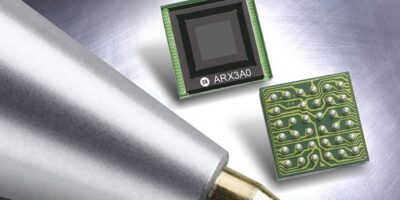Intelligent vision systems for viewing and artificial intelligence (AI) can be implemented using the low power 0.3Mpixel image sensor announced by ON Semiconductor.
The ARX3A0 digital image sensor has 0.3Mpixel resolution in a 1:1 aspect ratio. It can perform like a global shutter in many conditions, with up to 360 frames per second (fps) capture rate, yet with the size, performance and response levels that relate to being a back-side illuminated (BSI) rolling shutter sensor, explains ON Semiconductor. It has a small size, square format and high frame rate, making it particularly suitable for emerging machine vision, AI and augmented reality/virtual reality (AR/VR) applications, as well as small supplemental security cameras.
To meet the demands of applications that provide still or streaming images, the ARX3A0 is designed to deliver flexible, high-performance image capture with minimal power. It consumes less than 19mW when capturing images at 30 frames per second, and just 2.5mW when capturing one frame per second.
The 1/10 in square format enables low height modules and the 3.5 mm die size helps maximise the sensor’s field of view. It can therefore be used in emerging applications where orientation is not fixed but space is limited, such as AR/VR goggles, monitoring the wearer’s eye movement. Eye movement data can be used to adjust the image viewed and possibly mitigate motion sickness. Another application is simultaneous localisation and mapping (SLAM), which can also capitalise on the ARX3A0’s size and low power.
The monochrome sensor is based on a 560 by 560 active-pixel array featuring ON Semiconductor’s NIR+ technology, giving it high sensitivity at near IR wavelengths for performance in no-light conditions or when lighting is used that is non-detectable by the human eye.
Power management features include the ability to automatically wake from a low power mode when detecting motion or lighting changes in the scene. This allows the sensor to become the main source of wake for an entire camera system saving even more system power.
Gianluca Colli, vice president and general manager, Consumer Solution Division of Image Sensor Group at ON Semiconductor said: “As we approach an era where AI is becoming an integral part of vision-based systems, it becomes clear that we now share this world with a new kind of intelligence. The ARX3A0 has been designed for that new breed of machine, where vision is as integral to their operation as it is ours.”
The ARX3A0 is available in both chip scale package and reconstructed wafer die. Evaluation boards running on ON Semiconductor’s industry leading PC-based DevWare system and prototype modules are also available through ON Semiconductor and authorised distributors.







